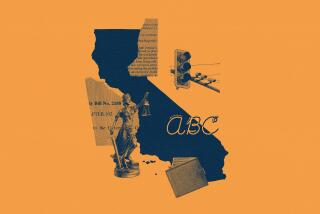The Fight Against Crime: Notes From the Battlefront : A Sober Look at Life as a DUI Offender
- Share via
Murray Greenfield--the first person in Los Angeles to be sentenced under the new state law on drunk driving--has a problem.
It’s a problem Franz Kafka or the characters in “Catch-22” could appreciate.
Greenfield, who lives in Van Nuys, pleaded no contest last week in Van Nuys Municipal Court to driving under the influence. It was his second violation within seven years and the new law, which went into effect on July 1, required that he have an breath analyzer unit, officially known as an ignition interlock device (IID), installed in each of the two vehicles he owns.
The unit will not allow a vehicle to start until Greenfield breathes into it through an attached plastic tube. If the IID detects anything less than the legal alcohol level on his breath, it releases the interlock and the vehicle can start. Otherwise, his vehicle is suddenly rendered even more useless than those on the Ventura Freeway on Friday afternoon at 5 p.m.
According to this law, the devices must remain in the vehicles for one year.
Now, here’s the problem. There is another law that has been on the books for several years. It requires that second-time driving under the influence violators must have their licenses suspended for, you guessed it, one year.
So Greenfield is not allowed to drive for one year. But he has to have breath-analyzing equipment installed in his cars so that when he breaks the law, he does so in a sober way.
“It’s a little crazy,” said Dennis Giroux, whose Alternative Action Programs company has been providing “one stop shopping,” as he puts it, in DUI services since 1977. In four locations, he offers court-mandated classes, group therapy and individual counseling for DUI offenders.
His company is the closest to Van Nuys, according to the city attorney’s office, providing IID services.
“There are states where judges can order the interlock devices and at the same time allow driving, as long as the device is used,” Giroux said. “In California what we are essentially saying is, you are not allowed to drive, but we know you are going to drive anyway.”
Giroux motioned out the window to the street, which was lined with parked cars.
“I’ll bet you had trouble parking today,” he said. “Well, we have a DUI group meeting, here, right now.”
He shrugged and shook his head.
“The state knows that if you are in L. A. you have to drive. It’s a way of life.”
The acting supervisor of the city attorney’s office, which prosecuted the case against Greenfield, recognizes the “Catch-22” nature of the situation.
“From my own point of view,” said Richard Schmidt, “it is not the most unusual thing that persons ordered not to drive will drive anyway.
“And if that happens, at least the new interlock device will guarantee that if they do drive their car, they will be sober.”
Of course, the offender could always bring along a friend to take the breath tests or simply drive a car not equipped with an IID.
But the offenders in the group meeting at Alternative Action Programs that day mostly agreed that the devices would do some good.
“It’s a reminder,” said a Woodland Hills resident in the group. “What I have learned is that drinking and driving takes away from your life. In all ways.
“The device is just another reminder of that.”
Another man said an IID might keep him from putting himself and others in danger.
“I’m an alcoholic and I know that if I go out of control and have a drink, all the fear melts away,” he said.
“The fear of the police, the fear of going to jail. It’s gone.
“If that happens to me somewhere, at least with this device I would not be able to drive.”
More to Read
Sign up for Essential California
The most important California stories and recommendations in your inbox every morning.
You may occasionally receive promotional content from the Los Angeles Times.














